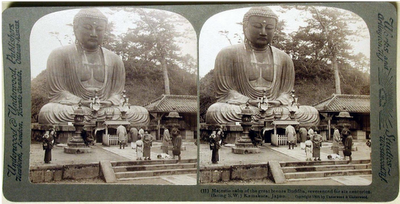 |
| Fuente: ebay |
 |
The Daiboodh, or Colossal Bronze Image of a Buddhist Idol, in the Temple of Kakamura, Japan
Fuente: University of Puget Sound |
The Illustrated London News 1865 (18 de febrero, página 193)
Título: The Daiboodh,or Colossal Bronze Image of a Buddhist Idol,in the Temple of Kamakura, Japan
Size: 280 mm x 410 mm
Fuente: ebay
Observaciones: ¿es posible que el dia sea el 18 de febrero? (tal vez el 25?).
En el texto se puede leer que su corresponsal en Yokohama (
Charles Wirgman ?) ha enviado un esbozo para el grabado de la ejecución de dos japoneses relacionados con el asesinato de dos oficiales ingleses, el
major Baldwin y el
lieutenant Bird cuando iban a visitar el Daibutsu de Kamakura. Este suceso es conocido como el incidente Geba y que es justamente el que sirve de excusa para esta ilustración en el The Illustrated London News:
The Geba Incident
At the end of the Tokugawa shogunate there were several incidents involving violence against foreigners, the most famous of which is the Namamugi incident. In 1864 two Britons were slashed to death at this intersection by some Japanese men[16].
On November 22, 1864[17] British cartoonist Charles Wirgman and photographer Felice Beato were in Enoshima near Fujisawa, where they met Major Baldwin and Lieutenant Bird of the British garrison in Yokohama[18]. Wirgman invited the two men to join them, but they declined because they wanted to go and see the Kamakura Daibutsu.[18] On November 22 the two men were sketching near Wakamiya Ōji when they were stopped and murdered by some samurai.[18] Three men were arrested and executed for the crime, and the head of their leader was publicly displayed in Yokohama.[18] Baldwin and Bird were laid to rest in Yokohama's Foreign Cemetery.[18] (Fuente: Wikipedia)
La web
The Illustrated London News (ver: March 18th) anota estas ilustraciones relacionadas con este incidente y que pueden verse en la web de la University of Puget Sound:
 |
Avenue Leading to the Temple of Kakamura, near the Scene of the Murder of the Two British Officers in Japan
Fuente: University of Puget Sound |
Apéndice: Geba Yotsukado da posiblemente nombre al incidente, donde la avenida Ōmachi Ōji se cruza Wakamiya Ōji.:
Between Ichi no Torii and Ni no Torii lies the Geba Crossing (下馬四角 Geba Yotsukado?), where Ōmachi Ōji crosses Wakamiya Ōji. The etymology of the name Geba ("Dismount horse") is interesting.(Fuente: Wikipedia)
El fotógrafo Felice Beato posee una serie de imágenes relacionadas con este incidente pero que datan de 1868 y sirvieron como ilustración (ver páginas 30-32 de Our life in Japan):
Our life in Japan; with illustrations from photographs by Lord Walter Kerr and Signor Beato and native Japanese drawings (1869), Jephson, Richard Mounteney, Elmhirst, Edward Pennell. London, Chapman
The view represents the execution ground, about a couple of miles from Yokohama, where the murderer of Major Baldwin and Lieut. Bird,—the notorious Shimidzu Seiji—was executed in December 1864. The executioner is a well known old practitioner, who, by his own account, has in a year when business is brisk, a very tolerable income. He receives some 7 ichiboos (about $2.30) per head, and has taken off as many as 350 heads in a twelvemonth. His office, however, is a despised one. (Fuente: Luminous-Lint)
 |
| This albumen print shows the site where Major Baldwin and Lt. Bird were murdered in Kamakura and has a description in the top right corner reading "Spot where Major Baldwin and Lt. Bird (of the 20th) were cut down by Japanese assassins near the temples of Kamakura (Fuente: Luminous-Lint) |
 |
| Photographer Frederik William Sutton shows accused collaborator Ichikawa Shaburo prior to his execution (Fuente: Luminous Lint) |
 |
| This unattributed view shows the head of Parkes' assassin, Hihashida. Penned in ink, possibly by Beato, under each photo reads: "Itchikkawa Shabro, Gaung usashinguzu (?), a priest taken prisoner at the attack on Sir Henry Parkes, 23 March 1868" and "Head of Hi-hashi-da, a medical student (one of the Kioto assassins) who attacked Sir Henry Parkes when going to visit Mikado, 23rd March '68, & was killed on the spot by Yakunin Gotoshojiro, officer of the Mikado court." (Fuente: Luminous Lint) |
 |
| Felice Beato (attributed). Post-mortem of Lt. Camus - attributed to Felice Beato. Shows the badly mutilated corpse of Lieutenant Camus who was assassinated by anti-foreigner Samurai on the outskirts of Yokohama, Oct. 1863. On the verso of the print, penciled in unknown hand, possibly by Beato, are several graphic accounts detailing the assassination of Camus indicating that Camus was a French Military officer and was assassinated by three Ronin on 10/18/1863, in the suburbs of Yokohama, while on horseback. It indicates that this photograph was taken in order to report the atrocity to France. (Fuente: Luminous Lint) |

















































